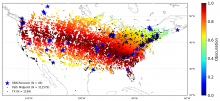Solar Eclipse QSO Party First Results Published
Solar Eclipse QSO Party First Results Published

The first science results from the 21 August 2017 Solar Eclipse QSO Party have been published in the American Geophysical Union journal Geophysical Research Letters. In the paper, "Modeling Amateur Radio Soundings of the Ionospheric Response to the 2017 Great American Eclipse," Nathaniel Frissell, W2NAF, and team present Reverse Beacon Network (RBN) observations of the SEQP and compare them with raytracings through an eclipsed version of the physics-based ionospheric model SAMI3. On 14 MHz (20 m), eclipse effects were observed as a drop-off in communications for an hour before and after eclipse maximum. On 7 MHz (40 m), typical path lengths extended from about 500 km to 1000 km for 45 minutes before and after eclipse maximum. On 1.8 MHz (160 m) and 3.5 MHz (80 m), eclipse effects were observed as band openings 20 to 45 minutes around eclipse maximum.
By using raytracing to compare these observations with the SAMI3 model, it was found that the majority ofthe 14 MHz signals refracted off the ionosphere at heights less than 125 km (E region). On the lower bands, 1.8, 3.5, and 7 MHz, it was found that signals likely refracted off heights greater than 125 km (F region). These observations suggest an eclipse-induced weakening of the ionosphere, and are consistent with numerous prior HF radio eclipse ionospheric studies.
In total, the SEQP generated over 618,000 RBN spots, 630,000 WSPRNet spots, 1.2 million PSKReporter spots, and 29,000 log QSOs. This paper, along with the geolocated RBN data with solar eclipse obscuration values used in the paper, are being published under an open-access license to allow for further research. The data files can be found under the Supporting Information section of the paper. Additional HamSCI eclipse data can be found at https://zenodo.org/communities/hamsci.
Permanent link to SEQP Paper: https://doi.org/10.1029/2018GL077324
